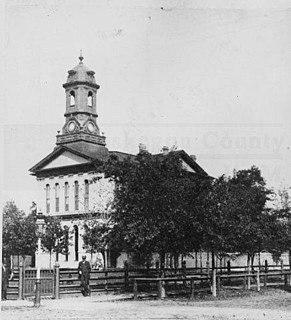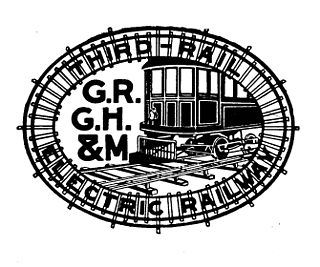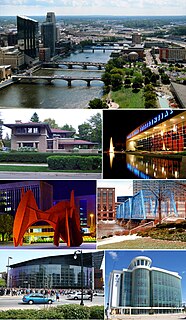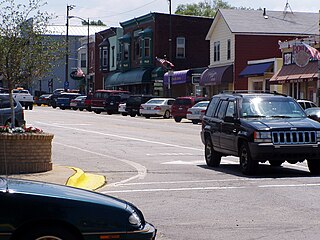
Muskegon County is a county in the U.S. state of Michigan. As of 2014, the population was 172,344. The county seat is Muskegon.

Crockery Township is a civil township of Ottawa County in the U.S. state of Michigan. As of the 2010 census, the township population was 3,960.
US Highway 16 (US 16), also called Grand River Avenue for much of its length in the state, was one of the principal pre-Interstate roads in the state of Michigan. Before the creation of the United States Numbered Highway System in 1926, the highway had been designated M-16. The modern route of Grand River Avenue cuts across the Lower Peninsula in a northwest–southeast fashion from near Grand Rapids to Detroit. Before the late 1950s and early 1960s, US 16 followed other roads between Muskegon and Grand Rapids, and then Grand River Avenue through Lansing to Detroit. In the years immediately preceding the creation of the Interstate Highway System, US 16 was shifted from older roads to newer freeways. Later, it was co-designated as an Interstate. When the gap in the freeway was filled in around Lansing, the US 16 designation was decommissioned in the state. The freeway was then solely designated Interstate 96 (I-96) east of Grand Rapids and I-196 west of that city.

West Michigan and Western Michigan are terms for an arbitrary region in the U.S. state of Michigan's Lower Peninsula. Most narrowly it refers to the Grand Rapids-Muskegon-Holland area, or more broadly to most of the region along the Lake Michigan shoreline of the Lower Peninsula, but there is no official definition for it.

The Grand Trunk Western Railroad Company is an American subsidiary of the Canadian National Railway operating in Michigan, Illinois, Indiana and Ohio. Since a corporate restructuring in 1971 the railroad has been under CN's subsidiary holding company the Grand Trunk Corporation. Grand Trunk Western's routes are part of CN's Michigan Division. Its primary mainline between Chicago, Illinois, and Port Huron, Michigan, serves as a connection between railroad interchanges in Chicago and rail lines in eastern Canada and the Northeastern United States. The railroad's extensive trackage in Detroit and across southern Michigan has made it an essential link for the automotive industry as a hauler of parts and automobiles from manufacturing plants.

M-104 is a state trunkline highway in the US state of Michigan in the Western Michigan region of the state. It runs from Ferrysburg to Nunica in Ottawa County, passing through Spring Lake. The highway serves as a connector between Interstate 96 (I-96) and US Highway 31 (US 31), helping connect Grand Haven with the Grand Rapids metro area. A related Connector 104 runs between the M-104 and US 31 in Ferrysburg. During the 1920s and 1930s, a different highway bore the M-104 designation. The current highway was previously a section of US 16 until 1940 when that designation was shifted to a road going from Nunica to Muskegon; the orphaned highway was redesignated M-104 at the same time. Since then, two routing changes have caused short segments to be transferred to local control and removed from the highway.

The Grand Trunk Milwaukee Car Ferry Company was the Grand Trunk Western Railroad's subsidiary company operating its Lake Michigan railroad car ferry operations between Muskegon, Michigan, and Milwaukee, Wisconsin, from 1905 to 1978. Major railroad companies in Michigan used rail ferry vessels to transport rail cars across Lake Michigan from Michigan's western shore to eastern Wisconsin to avoid rail traffic congestion in Chicago.
The Grand Rapids and Indiana Railroad at its height provided passenger and freight railroad services between Cincinnati, Ohio and the Straits of Mackinac in Michigan, USA. The company was formed on January 18, 1854.

The Grand Rapids, Grand Haven and Muskegon Railway was an electric interurban railway that operated in west Michigan from 1902 until 1928.
The Flint and Pere Marquette Railroad (F&PM) is a defunct railroad which operated in the U.S. state of Michigan between 1857 and 1899. It was one of the three companies which merged to become the Pere Marquette Railway.
The Chicago and West Michigan Railway (C&WM) is a defunct railroad which operated in the state of Michigan between 1881 and 1899. It was one of the three companies which merged to become the Pere Marquette Railway.
The Michigan Lake Shore Railroad (MLS) is a defunct railroad which operated in the state of Michigan between 1869 and 1878, and as the Grand Haven Railroad until 1881.
The Grand Rapids, Newaygo and Lake Shore Railroad is a defunct railroad which operated in the state of Michigan between 1872 and 1881. The GRN&LS was chartered on September 11, 1869, under the leadership of David P. Clay. The company operated a 46-mile (74 km) line between Grand Rapids and White Cloud. The initial segment, from Grand Rapids to Sparta, was completed on May 19, 1872. The line reached Newaygo on September 11, 1872; the first passenger train between the two towns ran the same day, to much fanfare from the local populace. On September 24, 1875 the line was extended over the Muskegon River to White Cloud. On September 30, 1881, it consolidated with other companies to form the Chicago & West Michigan. During its twelve years of independent existence the company sustained a net loss of $36,554.28.
The Ionia and Lansing Rail Road is a defunct railroad which operated in the state of Michigan in the 1860s and 1870s. The company incorporated on November 13, 1865; the investors hailed primarily from Lansing, Ionia and Portland. The original charter called for a 34-mile (55 km) from Ionia to Lansing; on January 13, 1869 this was amended with a much grander vision: a 125-mile (201 km) line from Lansing to the mouth of the Pentwater River at Pentwater, on the shores of Lake Michigan.
The Detroit, Grand Haven and Milwaukee Railway is a defunct railroad which operated in the US state of Michigan during the late 19th and early 20th centuries. Itself the product of several consolidations in the 1870s, it became part of the Grand Trunk Western Railroad in 1928.

The Grand Rapids metropolitan area is a triangular shaped Metro Triplex, in West Michigan, which fans out westward from the primary hub city of Grand Rapids, Michigan to the other two metro hubs of Muskegon and Holland. The metropolitan area has an estimated population of 1,059,113 as of 2017. The region, noted in particular for its western edge abutting the Lake Michigan shoreline and its beaches, is a popular tourist and vacation destination during the summer. Noted popular metro area beach towns include Grand Haven, Holland, Muskegon, and Saugatuck.

The Chesapeake & Ohio Railway Station is a railway depot located in Pioneer Park on West Lake Street in Petoskey, Michigan. It was placed on the National Register of Historic Places in 1970. The building now houses the Little Traverse Historical Museum.











